 7.7cm Feldkanone m96 n.A.
7.7cm Feldkanone m96 n.A.
| 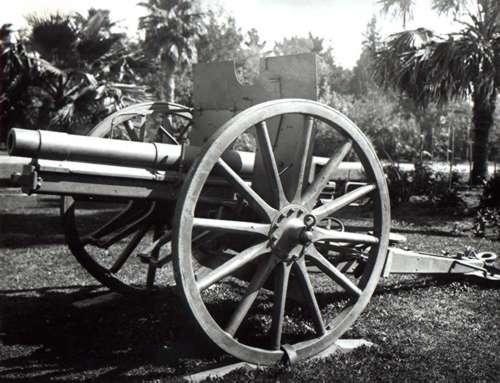 The by far most numerous gun in the arsenal of the German Imperial Army in 1914 was the 7.7cm Feldkanone 96 n.A.. Germany entered the war with 5.086 of these Field Gun. Throughout the whole Great War, it stayed the workhorse of the German Artillery, and though as such not as well-known as many other, large-calibre pieces, it was of course very important, being used on all fronts and in all battles. The by far most numerous gun in the arsenal of the German Imperial Army in 1914 was the 7.7cm Feldkanone 96 n.A.. Germany entered the war with 5.086 of these Field Gun. Throughout the whole Great War, it stayed the workhorse of the German Artillery, and though as such not as well-known as many other, large-calibre pieces, it was of course very important, being used on all fronts and in all battles.
Interestingly, the Feldkanone 96 n.A. started it's career as the Feldkanone C/96, a Field Gun with rigid carriage and of surprisingly traditional design, with no shield and the old type of ammunition, with separate cartridges and projectiles. It was all result of the conservatism in the army's leading circles. The Germans had just started to distribute the FK C/96 to the troops, when the French introduced their famous "75", a gun that revolutionized gun design forever. And over-night the French gun made the technically new German C/96 completely obsolete.
The problem was, that the German Army had used up most of it's allocated money on the old design, and only way to get a new gun fast, was to subject the C/96 to a major redesign. The job went to Rheinmetall and Krupp, who did a complete overhaul, in principle only keeping the barrel - to save money - and the wheels, but putting in on a new trail, a new hydro-pneumatic recoil system, a shield, and a new breech. The result was the Feldkanone 96 n.A., n.A. standing for neuer Art, "new model". Existing guns were mostly converted, and in addition to this many completely new guns, from the wheels up, were also manufactured.
  
It was a sound design, although not as spectacular as the French "75". The breech was of the single-motion sliding wedge type. The recoil was absorbed by a hydraulic buffer (glycerin) of pretty simple but sturdy design, complemented by four recuperator springs (set in the cradle). The barrel and cradle sat on the straight wheel axle, on which it was elevated and traversed by a simple mechanism, both cranking wheels being to the left, being operated by the gun layer. The trail was of the straight box type, open at the inner end, and with a spur piece with spike permanently attached to the end. It had a shield 3mm thick, set behind the axle, and divided into three pieces, with the upper and lower parts being foldable. (Lower and upper shield was always folded during transport.) The wheels had a double brake, that was used both during transport and as an additional means of securing the piece during firing.
 
The main ammunition was the FKG11 (FeldkanoneGeschoss = Field Gun Projectile) which was a Einheitsgeschoss, i.e. a sort of universal projectile, combining High Explosive with Shrapnel. It's weight was 6.85kg, containing 294 lead 10 gram bullets, and 0.25 kg of FP02, Füll-Pulver 02 i.e. TNT. This was complemented by the FG96, Feldgranate 96, 6.8 kilos heavy, with 0.19 kilos of FP02, plus a pure Shrapnel grenade, also 6.8 kilos heavy, but containing 300 10 gram lead bullets. In addition to this, there came star, smoke and a number of different blue-cross shells i.e. gas projectiles. The fuses used were principally the K.Z.11, a time fuse (at the photo above the fuse to the left) and the later L.K.Z.16 a contact fuse - see the two other, dark coloured fuses. The last were designed to explode immediately on contact, without any delay, hence the nickname given to these grenade by the British soldiers: "whizzbangs". (Colour of the shell to the left: black, with red nose and alloy fuse, colour of centre shell: blue with yellow nose and yellow band at bottom plus blackcoloured alloy fuse, colour of right shell: yellow with blackcoloured alloy fuse.)
  
The design of the Feldkanone 96 n.A. must be seen against the background of German tactical doctrine prior to 1914. The German Army was wholly and fully dedicated to a swift, fast war of maneuver: home before the leaves fall and all that. Therefore mobility and speed of emplacement was given first priority when designing the gun. Which meant that the weight of the gun was kept as low as possible, leading, among other things, that the barrel was comparatively short, giving the gun a pretty low muzzle velocity, compared to other contemporary field guns.
 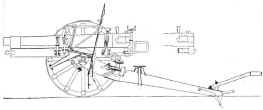 
But as the role of the gun was to follow closely the infantry in it's sweeping movements on the battlefield, giving it close support, range was secondary. Indeed, firing at ranges over 5.000 meters was considered both rare and pointless - observation at these ranges was very difficult, among other things due to the small charges used in the german grenades, which gave comparatively tiny detonations, hard to spot. Actually, in many Corps firing at ranges over 5.000 meters was expressly forbidden before the war, considered to be a waste of ammunition!
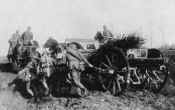   
And initially, the gun worked as thought. Indeed, it did excellent service, especially on the Eastern Front. For example during the Battle of the Masurian Lakes, this comparatively light gun was the only one capable capable of following and supporting the Infantry of the left flank in their moves through many times difficult terrain. (Guns like the heavier British 18-pounder or the french "75" would have had considerable difficulites in the same terrain.) And during the long, fast marches on the Western Front in the early autumn of 1914, the FK 96 n.A. also proved it's value as a very mobile Field Gun. And the mostly shrapnel-based ordonance also worked pretty well.
   
But then the War of maneuver ended in the West, and the Trench War came in it's place. And then the short-comings of the piece became obvious. It was superior to the field guns of the enemy armies only in one respect: the mobility, but that was of course not such a big benefit during the stalemate. The field guns of it's opponents could all shoot longer - the French "75", the Russian Putilov 02 and the British 18-pounder. (If ranges over 5.000 meter would be reached, the FK 96 n.A. had to have it's tail dug into the ground, thus increasing the elevation.)
  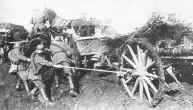 
In addition to this, the "75" had a higher rate of fire and used better shells, and the 18-pounder bigger ones. In many times, this difference was in practice well near eradicated by the bigger number of german guns, or by the fact that the german field artillery also employed an effective light howitzer, the lFH 98/09. And also, the opponents guns also had problems, for instance the "75" was plagued by misfires, and by falling accuracy at longer ranges. (The "75" also had a more complicated design, making it more difficult to maintain or repair than the pretty sturdy FK 96 n.A..)
  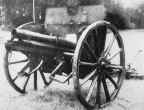 
Still, it was obvious that although the Fk 96 n.A. was far from a flop, it had obvious problems. And while both the French and the British tried to improve the performance of their main gun by simply improving the ordonance, the Germans were the only ones to introduce a completely new gun, the 7.7 cm Feldkanone, which used a longer barrel, plus a howitzer type carriage in order to increase the range of the gun. (The ammunition was the same as the FK 96 n.A..) But this came at a cost. That design was both more complicated and considerably heavier: the weight of a limbered FK was 2256 kilos, as compared with the FK 96:s 1910 kilos. But it is proof of the soundness of the design of the gun, that when war in the spring of 1918 reverted to the type of conflict anticipated before in 1914, i.e. a war of movement, in many batteries the FK 16 was actually replaced by the older but more mobile FK 96.
 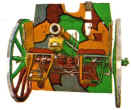 
Specifications | Calibre | 77mm | | Length of barrel | 2080mm | | Maximum recoil | 1270mm | | Weight of barrel | 335 kg | | Elevation | -12° to +15° | | Traverse | 4° | | Axle width | 1530mm | | Wheel size | 1360mm | | Weight of carriage | 635 kg | | Weight limbered | 1910 kg | | Weight emplaced | 1020 kg | | Weight of shell | 6.85 kg | | Muzzle velocity | 465 kg | | Maximum range (theoretical) | 7.800 meters | | Maximum range (without digging) | 5.000 meters |
| | FK 96 n.A. Walk-Around | The first 7.7cm Feldkanone 96 n.A. it sits on a small island in the middle of an intersection in the town of Scotch Plains, New Jersey, where it has been photographed by Mike Casale. And this is a very interesting collection of photos, because this is, paradoxically enough, a rather rare gun. He says that "it's in pretty good shape, but sitting outside for many years is causing it to rust out in some places". The grey paint is evidently not the original one. The six next photos have been taken by Philippe Massin, and shows a FK 96 in almost pristine condition, that is kept in the Army Museum in Brussels. And the final five ones are taken by myself, also in the Army Museum in Brussels, but showing a gun - with the upper shield folded - currently tucked away at the Armoured Vehicles display. the photos
| 7.7cm Feldkanone 96 n.A.
by Leslie F. Thurston | The German 7.7 cm field gun was born during the last decade of the nineteenth century and came of age some ten years later during the first decade of the present century. Most countries were in the throes of modernising artillery weapons and it was the field equipments that were receiving more attention than the heavier weapons, such as coast defence and naval guns. The reason for this was that while most field artillery weapons had little means of controlling recoil and required relaying after each shot, the heavier guns utilised the weights of the fixed mountings combined with crude methods of spring recuperation to absorb recoil energy and return the piece to battery ready for the next round. Earlier recoil controlled field carriages were based on similar systems but few were very efficient in keeping the equipment stable and much energy was expended by the gun crews in re-laying after each shot.
The most remarkable achievement of this period was the design adopted in 1897 by the French Army. This was the famous 75 mm field gun with compressed air recuperation and many other new features that were years ahead of all rival equipments. While this weapon was under development and during the years that French artillery units were being equipped with it, Great Britain, Germany and the other arms producing nations were striving to build stable recoil controlled field carriages but were not having the same success as the French. The The best that Britain could muster was the 15 pounder breech loader in which the gun was still attached to a rigid carriage and relied on a spade pivoted to the axle-tree connected by cable to a spring in the trail to prevent the weapon from running back too far on firing. The first model German 77 mm field gun was similar in many respects, the only difference being that the spring spade was built into the end of the trail. Unsatisfactory as this equipment was, rumours of the marvellous new gun the French were building had caused concern in German military circles, and, coupled with the success of the French in keeping all details secret, prompted the Germans to take it into service to replace the existing outdated 9 cm field gun. As it was customary in those days, the year of adoption was attached to the title in the official nomenclature to identify the weapon. It entered service in 1896 one year before the French gun and by the time the superiority of the latter was realised, large numbers had been issued which ruled out any possibilities of starting afresh with a completely new weapon utilising the improved methods of recuperation that began to appear in later years.
In the immediate years following 1900 it was clear that weapons produced by the great gun makers for sale on the open market were far in advance of official military patterns which were subject to the customary long period of development testing and evaluation usually demanded by the military authorities. The inevitable frustrating delays associated with the latter procedure usually left the traditional arms-producing countries at a certain disadvantage as it was possible for the smaller states of the world to go straight to the gun makers and pick up the very latest patterns available. This is what was happening in Germany. While the 7.7 cm Model 96 became the standard field gun of the German artillery, Krupp and Erhardt were busily supplying countries all over the world with vastly superior weapons and ammunition. Even Britain had taken the unprecedented step of buying modern recoiling 15 pounders from Erhardt after the lessons learnt from the Boers in South Africa, who had not been slow in taking advantage of this unique situation in arms supply.
It is not hard to imagine the bitter controversies that must have raged between the military on the one hand and the government officials on the other about the course of action to be taken regarding this very unsatisfactory state of affairs. In order to remedy the situation work began to convert the weapons to bring these into line with the equipments of other countries. Although the end product bore little resemblance to the original piece it still retained the title 7.7 cm Field Gun 96 but n.A. (neuer Art-new pattern) was added which was usual when military equipment was modified in some way.
In the new piece the gun was retained but without trunnions and was fitted with chase rings and guide pieces to enable it to slide back in the cradle. The breech mechanism was changed from the earlier two motion sliding wedge pattern to a single motion type similar to designs produced by Erhardt. To absorb recoil and return the piece to battery a simple hydraulic buffer and single column of running up springs was housed in a trough-like cradle below the gun connected to a horn fixed below the breech. This assembly was mounted on a vertical trunnion fitted to a sleeve around the axle tree upon which it traversed and elevated by means of relatively simple operating mechanisms.
The carriage had a long box trail open at the inner end to permit a maximum elevation of 16° and allow for 44 inches of recoil. This amount of recoil plus a low muzzle energy of 241.7 foot tons created a remarkably stable equipment requiring no further means of steadying the carriage while in action. The brakes were used for travelling only. To protect the crew from rifle bullets and shrapnel balls a 4 mm thick shield was provided in front of which two axletree seats could carry two crew members.
Although shrapnel shells were at that time accepted standard ammunition for field guns the Germans had been carrying out trials with a combined shrapnel and high explosive shell or universal shell (Einheits-Geschoss). Several patterns of this type of shell were tried and experimented with, the final pattern of which saw use in the 1914-18 war. Although in some applications such as a direct hit on a gun shield or air bursts directly above troops, it was reasonably successful, the universal shell lacked the tactical value of straight high explosive or shrapnel shells when used in their normal roles.
Germany entered the 1914-18 war well equipped with 7.7 cm guns of the new pattern as well as a formidable array of heavier field guns and howitzers of all calibres up to 420 mm. Compared to the British 18 pounder (firing a shell some three pounds heavier) and the rapid firing French 75, the 7.7 cm 96 n.A. could best be described as a very serviceable gun but slightly lacking in firepower. Nevertheless it remained in service throughout the war years and even saw military service with the Reichswehr in the 1920s, although a newer much improved model the 7.7 cm Field Gun 16 began to appear during 1916.
Ammunition for the model 96 n.A. was fixed, that is the shell was secured in the case, but in the model 16 separate loaded rounds were used. This was to enable a greater range of charges to be used which was one of the disadvantages of the former. The same cartridge case was used in both types, the only recognisable difference being the corrugated appearance at the mouth of the fixed cases where it crimped into the grooves around the base of the shell. These are quite common in antique shops today and are becoming more sought after as collector's items.
The wide range of projectiles issued for use in both models of the 77 included high explosive, shrapnel, universal, star, smoke and many patterns of gas shell. As the war progressed a new long pattern high explosive shell was introduced containing a 2 pound bursting charge, which was more than twice the weight of the explosive in the standard shell of 1915 and five times that contained in the 1914 pattern. With these shells came an instantaneous percussion fuse which detonated the shell before it had time to bury itself in the ground. Because the explosion followed the whine of the incoming shell without the slight delay that was experienced with earlier ammunition, the new type was given the nickname "Whizz bang" although it is quite likely that this name was applied to other types of ammunition also. At all events this nickname was immortalised in a well-known British soldiers' song of the period.
As well as its standard role as a field gun, the 77 was used in many other ways. One of the most improbable was as an anti-aircraft gun in which the whole carriage was mounted on trestles and pointed upwards. The means of traversing and laying were very crude and it is doubtful whether this particular application was very successful. This field improvisation should not be confused with the many more practical adaptations on more formal antiaircraft mountings prepared at the gun factories. As an infantry gun the field carriage was lightened and smaller wheels were fitted. In this form it also served as an anti-tank gun when this particular type of target heralded a new form of warfare. To counter British tanks the standard 1915 pattern high explosive shell was fitted with a hardened steel nose in place of the nose percussion fuse and a special internal percussion fuse was designed to detonate the reduced explosive charge after penetration through the side of the tank, a quite effective method bearing in mind the fairly rudimentary quality of early armour plate.
|


|





 Similar Threads
Similar Threads

